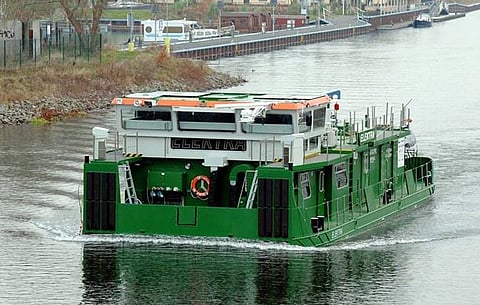

A new hydrogen-fueled inland pusher tug recently arrived at the Port of Westhafen near Berlin to undergo a series of trials to prepare it for operational service.
Elektra was built by Germany's Schiffswerft Hermann Barthel, which claimed that the vessel is the first tug in the world to be fitted with hydrogen-fueled engines. The tug has a length of 20 metres, a beam of 8.2 metres, and a draught of 1.25 metres.
The trials are being carried out by Hermann Barthel in partnership with Berliner Hafen- und Lagerhausgesellschaft (BEHALA), Ballard Power Systems, ARGO–ANLEG, Schiffselektronik Rostock, EST-Floattech, and HGK Shipping. The project team expects to make Elektra's hydrogren fuel cell technology adaptable to a wide range of vessels that sail on both inland and coastal waters.
The hybrid system fitted on Elektra includes a battery package consisting of 242 DNV-approved modules with a total capacity of 2.5 MWh and three maritime fuel cell systems with 100 kW of peak power each. The battery was supplied by EST-Floattech.
The battery and the fuel cells will be used together to power the electric motors. However, for complete redundancy, the two powertrains were designed to operate as entirely independent systems.
The tug's total electric power capacity of 21,200 kWh will enable an emissions-free round trip from Berlin to Hamburg. On hydrogen, it will be able to travel a minimum of 100 kilometres over a 16-hour day or longer.
The energy storage system (ESS) delivered by EST-Floattech has a raft of integrated safety features. Its unique active balancing and passive safety system is applied at the module and string level. Heat is dissipated by a simple off-the-shelf air-conditioning unit while the battery racks can easily be installed in a modular fashion. Diederick Stam, founder of EST-Floattech, said that monitoring of the installation, and in turn the assessment of its performance, can be done either onboard or remotely.
In addition to propulsion, the system provides energy for the temperature control of the cabins and the wheelhouse. The battery system also needs a certain "comfortable temperature" for efficient operation and a long lifespan. All of this must be done with a limited amount of carried energy and without loss of operational range.
The waste heat from the fuel cells is used through continuous water cooling and the cabins are heated by a brine heat pump. An additional advantage is that the ship always operates in water with temperatures above zero degrees Celsius underneath its keel.
The use of a self-developed energy management system and a digital sailing assistant support the captain and logistics planner with the planning of operations and transports.
With 750 kg of gaseous hydrogen (at a pressure of 500 bar) on board and a battery capacity of approximately 2,500 kilowatt hours, the ship has a range of approximately 400 kilometres when sailing in combination with the loaded heavy lift barge Ursus – developed by the Design and Operation of Maritime Systems department at the Technical University of Berlin (TU Berlin) – and numerous other cargo boats.
Elektra is to be used primarily for transportation of goods on the Berlin to Hamburg and inner-city routes in the German capital city. EST-Floattech said the tug's most important transportation task will be carrying Siemens turbines, which need to be shipped from the production site in the center of Berlin to the Western Harbour or to Hamburg.
Elektra was built under a €13 million (US$15.7 million) project funded mainly by the German Federal Ministry of Transport and Digital Infrastructure.
| Elektra | |
| SPECIFICATIONS | |
| Type of vessel: | Pusher tug |
| Flag: | Germany |
| Owner: | Technical University of Berlin, Germany |
| Builder: | Schiffswerft Hermann Barthel, Germany |
| Length overall: | 20 metres |
| Beam: | 8.2 metres |
| Draught: | 1.25 metres |
| Range: | 100 kilometres |
| Batteries: | EST-Floattech, 21,200 kWh |
| Type of fuel: | Hydrogen |
